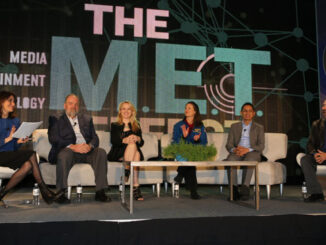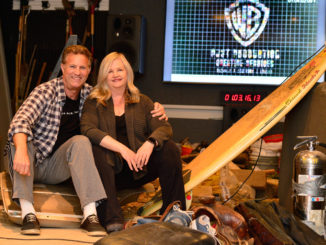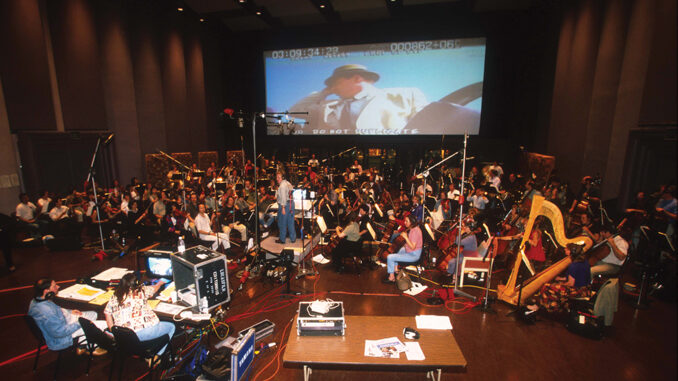
by Michael Kunkes
They say brevity is the soul of wit, and scoring mixers seem to have a sense of humor about what their job entails. “We get coffee for the composer. End of interview,” Alan Meyerson jokes. Well, not so fast.
In truth, the scoring mixers have one of the most complex, pressure-cooker jobs in post. Officially, their charge is to capture the composer’s original music in the live atmosphere of the scoring stage and, in the process, hopefully make it sound even better than the composer imagined. Part engineer, part recordist, part creative problem-solver, the scoring mixer is the interface between the director, composer, orchestrator/arranger, music editor and the dub stage, helping to determine how best to make a composer’s intent fit the director’s musical vision.
On the engineering side, the scoring mixer reviews the dynamics of the scoring stage. He also helps determine the size and positioning of the orchestra, placement and types of microphones, recording format, sample rates, ProTools rig configurations and turnover/delivery options. The bottom line is always time and money. A scoring stage filled with musicians is one of the most expensive per diems in the industry. The pressure to do it fast and get it right the first time is intense. It is a position of technical excellence and trust, because there’s rarely, if ever, any thought of going back and doing it a second time.
“‘We’ll fix it in the mix’ is not one of my favorite sayings,” says Robert (Bobby) Fernandez, CAS, who has engineered and mixed the scores for over 400 titles during the past 34 years and all of Clint Eastwood’s films since the early 1980s, including the 1988 Best Sound Oscar winner Bird. Fernandez ran the Warner Bros. scoring stage for much of his 24 years at the studio before going independent ten years ago. “If you can capture a score live and properly record it, this job is so much easier,” he claims.
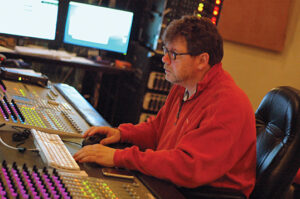
The ability to record live is the key to understanding the scoring mixer’s art, and many of the best come from the record industry. Meyerson was a session engineer at New York studios such as A+R and the Hit Factory in the late 1970s and early 1980s, then moved to Los Angeles to pursue a career as a record producer. Along the way, he engineered albums for artists such as Bryan Ferry, New Order, Bronski Beat, Jody Watley, Luther Vandross and the Commodores. “One day I was invited to an overdub session on Hans Zimmer’s score for Renaissance Man and got booked for four months. That was some 150 movies ago.”
Dennis Sands, CAS, began recording live music in the late 1960s, working at MGM Records with artists such as Sammy Davis, Jr. and Steve Lawrence and Edie Gorme, as well as numerous jazz, orchestral and soundtrack recordings. “Early on, I was exposed to recording a lot of live orchestral music, as opposed to overdub- bing one instrument at a time, which was more the rock ‘n’ roll style,” Sands recalled. “One night, I helped someone out on a film score; it was incredible, and I realized that was what I wanted to do.” Sands has worked on over 200 films, with recent credits that include A Christmas Carol (scoring and re-recording mixer), Terminator Salvation, Bruno, Milk and Dreamgirls, and was honored with a 2008 career achievement award from the Cinema Audio Society.
Most of the feature work on the West Coast is done at three venerable scoring stages in Los Angeles: Sony, Fox and Warner Bros. The exception is the Skywalker Scoring Stage at Skywalker Sound in Northern California’s Marin County, which is presided over by Leslie Ann Jones, the studio’s director of music recording and scoring since 1997. The daughter of 1940s novelty bandleader Spike Jones and singer Helen Grayco, Jones has engineered albums for Miles Davis and Quincy Jones, Dave Edmunds, Carlos Santana and Cris Williamson, as well as Grammy-winning recordings from the Kronos Quartet and Dianne Reeves. She is a trustee of the National Academy of Recording Arts and Sciences.
Jones had her first taste of film score mixing on Apocalypse Now in 1979, and continues a hybrid careers a score mixer and recording engineer, with recent credits that include Zodiac (2007), The Company (2003) and Requiem for a Dream (2000). “George Lucas’ vision for sound was to have everything happening in the same building,” Jones says. “The LA-based studios have stages on the lot, but the work after the score may be done all over the city. What’s great about Skywalker is the co-mingling of music for film and music for records, which makes for a very creative experience.”
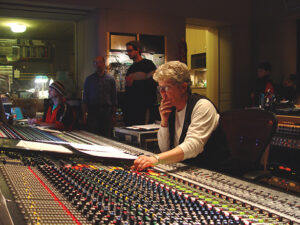
A typical 50-to-75- minute score usually will take a week to record, then another week to mix, but that time can vary greatly depending on the composer, says Greg Townley, a veteran scoring mixer who recorded his first symphony at age 22. His roster of nearly 100 films includes Reign Over Me, Sideways, Wedding Crashers and Black Hawk Down. “Composer Rolf Kent likes to do one or two cues per hour, but certain scores, such as some of Tom Newman’s, can be more experimental––so you are taking more time and developing the sound a lot more,” says the largely self-taught Townley. “More often, it’s conceived down to the point where we know exactly what we’re going to do.”
“What makes this such a high-pressure job is that there’s a lot that can go wrong,” says Jones, who is currently recording the score for God of War 3, a Sony PlayStation video game, as well as producing and engineering two recording projects for Bay Area artists. “You’re talking about 60 to 100 musicians working in three-hour increments. You can get a mic that goes bad, or you may have a director who’s heard a mock-up of a cue a million times, then gets to the stage and decides he doesn’t like the cue––and the composer may have to rewrite it on the spot. Suddenly, you’re talking about a lot of money; scoring stages are way more expensive than a traditional recording studio.”
Analogue score recording is a thing of the past, but no one is lamenting the loss. “Digital has changed the process quite a bit,” says Jones. “It used to be that the roles of the recordist and the music editor were fairly well delineated. Today, the recordist is more of a ProTools operator and editor, and the music editor puts the takes together after the music-mixing process is completed. Also, we now have the ability to record so much more and make all the recordings seamless. We can have more than one composer working on a project, as I’ve done on video game scoring mixes, and that’s only been made possible by the ability we have today to easily move files back and forth.”
Adds Sands, “ProTools is in some ways similar to multi-track recording, so I didn’t have much of a problem making the change, though the learning curve was substantial, and the difference in functionality is startling in terms of how fast you can access cues. On multi-track, there would be cues recorded on 24-track machines, DA-88s, DA-98s, or some other medium, and each one had to be dealt with individually. Changing from one cue to another was extremely time consuming, especially when we only have a ten-minute break each hour and need to play those cues for the director during that break. Before ProTools, we’d be lucky to have time to play one; now we can show him three or four. And if a given cue is a combination of three or more takes, we can quickly make edits and create what is essentially a finished cue.”
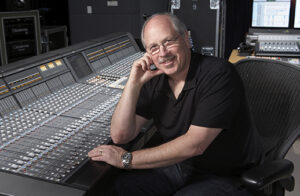
In setting up the scoring stage, most scoring mixers tend to use a standard orchestra left-to-right “wrap”––violins and violas next to each other on the left, French horns behind the violins and woods behind the violas, celli to the right with the double basses behind them, the brass behind the corner of the celli, and the percussion behind that. This arrangement traditionally provides the best overall stereo balance. However, says Meyerson, “More and more clients are being experimental and are willing to try all kinds of arrangements, especially when there is time to plan ahead. For example, on Black Hawk Down, we lined up the orchestra so that the brass and strings were playing at each other and it worked great!”
Mic placement with properly adjusted levels is a key to effective orchestra record- ing for film, and everyone has his or her own technique. Explains Meyerson, “I tend to rely on certain mics, but even then, I tend to change things up a lot. On Pirates of the Caribbean and Pearl Harbor, I used a lot more ribbon mics than I normally do, because I knew how aggressive the mix was going to be and wanted to have a very tactile sound. With ribbon mics, I was able to lower the levels so that the score could be heard better when put up against all the sound effects.”
Says Sands, “I don’t use an abundance of mics, about 12 to 15 for most of the sound. It’s all very specific: a lot of omni-directionals, three Neumann M-50s that I use for overall room ambience, and some cardioids that I use for spot mics, as well as some ribbons. The variety depends on the purpose or the section I am recording. I like it to sound big; if you’re going to have a lot of players, you want to hear a lot of players. That sweeping dramatic effect helps sell the emotional component of the music.”
Townley says that he records with a unique orchestral placement. “I like a very wide perspective to the orchestra, one that is pushed back inordinately to the far left and far right,” he says. I don’t like things clustered around the middle because that will affect the dialogue and sound effects. I’ve also developed a technique which I call ‘imagery micing,’ which gives 20 percent more depth of field to the orchestra.”
The advent of the DAW has changed the roles of the scoring mixer, composer and orchestrator. Composers are beginning to work more and more with electronic temp mock-ups, which serve roughly the same function for a score mixer as a temp dub does for re-recording mixers. “There are many composers today, such as Zimmer and Steve Jablonsky, who do almost all of the conventional orchestration in the computer and create a complete orchestral mock-up, which provides the orchestrator with the interesting job of duplicating the mock-up with the live orchestra,” Meyerson adds.
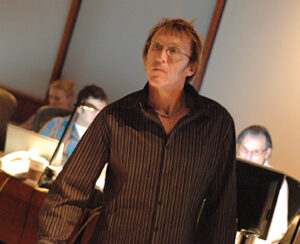
“A lot of the orchestrators I work with are masters of suggesting, for example, that a theme might sound better going back and forth between celli and violas, where it might have been written originally for one instrument,” he continues. “The composer will then take that a step further, and before you know it, you’ve created this beautiful mosaic. Modern orchestras are getting better and better at adding those additional textures that we wouldn’t be able to realize in just a synth mock-up.”
Fernandez, who recently finished work on director and composer Eastwood’s Invictus, as well as Joe Johnston’s The Wolfman with composer Danny Elfman, agrees that the job is changing. “It’s happened more than once that I’ve walked into a composer’s studio to talk about a film; they play me the mock-ups, and I say, ‘Why do they want me to mix this? It sounds great already.’ So it is getting to the point where we are at the mercy of this sonic road map. Instead of looking at the score, then recording and mixing it until we think it sounds right, it now becomes our job to make the final score sound like the mock-up or better. But mock-up or not, the last word on what the score needs to sound right still belongs to the guy who wrote it, and the director who is visualizing it.”
Many composers today are “writing smaller,” using fewer instruments and more sparse arrangements. Scoring mixers are then faced with the task of retooling both their orchestra setups and record- ing techniques. “On a smaller score, your job is to provide support for the dialogue mix. The more you let the music overpower things, the more they will pull it back in the dub,” Meyerson explains. “It’s easy today to make everything sound huge; the trick is to know that you can do that, but not take advantage of it fully. I did a movie this year called Inhale that had a magnificent score by James Newton Howard. But the score had to stay small because of the film’s indie feel. If you make the score sound too shiny, it won’t fit that style. It’s like putting a massive orchestra on stage behind a tiny lead singer; it just won’t add up.”
“On a smaller score, such as David Shire’s for Zodiac––which was mostly strings and a little bit of trumpet––I tend to go with mics that are quieter, such as condensers, which I will use as section mics, and only use a single mic per section to avoid the inherent noise of multiple micro- phones,” explains Jones. “The Skywalker Scoring Stage has an extremely low noise floor––it is a very quiet recording space––so it is important to work with equipment that won’t add noise, especially when working with a quiet score. With larger orchestras and bigger dynamics, I tend to go with large diaphragm micro- phones to get wider coverage and more space. I’m trying to capture the orchestra as a whole, not as individual pieces.”
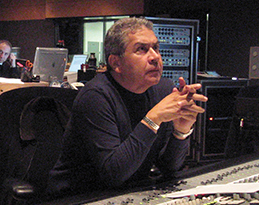
After the cues are recorded, the score is delivered to the dub stage for the final mix, usually in the high-resolution (up to 96K) WAV format. Says Meyerson, “Usually, I will give the mixers separate orchestra, percussion, guitars, synths, solo instruments and bass, so that they have broad, brush-stroke control and can pull one element down if it gets too big. On a lot of films today, they want everything separated and with today’s technology, you can’t deny them that, so I try and build in as much flexibility as possible. Within reason, of course.”
According to Sands, a score can be delivered to the dub stage in several ways; sometimes in a single 5.1 stem, but more often in a series of separate elements to provide the mixers at the final with a greater degree of control. “If the orchestra is split up, we will record strings and woodwinds on one pass and brass and percussion on another, and deliver those as separate stems,” he says. “Electronic material is much more complicated to divide up, and you have to approach that material very logically—perhaps big drums on one stem and high metallic percussion and synth pads on others. This becomes important on the stage because if there is a lot of dialogue to clear and a high-end percussion element is getting in the way, you can reduce that one element down without having to bring down all the remaining music. Dialogue is always king.”
Where will the next generation of scoring mixers come from? At a time when scoring stages are closing, live television score recording is disappearing, and the nature of scores themselves are changing, Fernandez offers a bit of positive wisdom. “I teach a class in ProTools mixing for film surround sound, and I always encourage young engineers to listen to as much live music as they can,” he asserts. “You can’t mix out of a box and understand what’s going on out there. If you can get it together recording alive group on stage, you can do it in the control room––but not before. This is a great art, and I believe in passing on what I’ve learned. There are new people out there; they just need the opportunity to learn.”
“The job a scoring mixer performs is a lot more than just recording an orchestra and mixing a score,” Townley says. “You need an amazing set of ears, and be able to remain cool under pressure. The score is the last new thing to be created at the end of this multi-year process of getting a film made. The amount of money being spent every hour can be quite large; the list of technical aspects you need to over- see is extensive.
“You’re the person in charge, standing at the console in front of the orchestra with the composer, the producer and the director all relying on you to bring their musical visions to fruition,” Townley concludes. “To survive in this environment, we all have to be bulletproof.”



